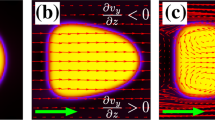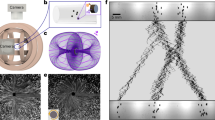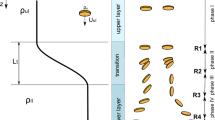Abstract
Buoyancy-driven flow, which is flow driven by spatial variations in fluid density1, lies at the heart of a variety of physical processes, including mineral transport in rocks2, the melting of icebergs3 and the migration of tectonic plates4. Here we show that buoyancy-driven flows can also generate propulsion. Specifically, we find that when a neutrally buoyant wedge-shaped object floats in a density-stratified fluid, the diffusion-driven flow at its sloping boundaries generated by molecular diffusion produces a macroscopic sideways thrust. Computer simulations reveal that thrust results from diffusion-driven flow creating a region of low pressure at the front, relative to the rear of an object. This discovery has implications for transport processes in regions of varying fluid density, such as marine snow aggregation at ocean pycnoclines5, and wherever there is a temperature difference between immersed objects and the surrounding fluid, such as particles in volcanic clouds6.
This is a preview of subscription content, access via your institution
Access options
Subscribe to this journal
Receive 12 print issues and online access
$259.00 per year
only $21.58 per issue
Buy this article
- Purchase on SpringerLink
- Instant access to full article PDF
Prices may be subject to local taxes which are calculated during checkout




Similar content being viewed by others
References
Turner, J. S. Buoyancy Effects in Fluids (Cambridge Univ. Press, 1973).
Phillips, O. M. On flows induced by diffusion in a stably stratified fluid. Deep-Sea Res. 17, 435–443 (1970).
Huppert, H. E. & Turner, J. S. On melting icebergs. Nature 271, 46–48 (1978).
Gurnis, M. Large-scale mantle convection and the aggregation and dispersal of supercontinents. Nature 332, 695–699 (1988).
MacIntyre, S., Alldredge, A. L. & Gotschalk, C. C. Accumulation of marine snow at density discontinuities in the water column. Limnol. Oceanogr. 40, 449–468 (1995).
Hoyal, D. C. J. D., Bursik, M. I. & Atkinson, J. F. Settling-driven convection: A mechanism of sedimentation from stratified fluids. J. Geophys. Res. 104, 7953–7966 (1999).
Wunsch, C. On oceanic boundary mixing. Deep-Sea Res. 17, 293–301 (1970).
Buckingham, E. The principle of similitude. Nature 96, 396–397 (1915).
Peacock, T., Stocker, R. & Aristoff, J. An experimental investigation of the angular dependence of diffusion-driven flow. Phys. Fluids 16, 3503–3505 (2004).
Woods, A. W. Boundary-driven mixing. J. Fluid Mech. 226, 625–654 (1991).
Page, M. A. & Johnson, E. R. Steady nonlinear diffusion-driven flow. J. Fluid Mech. 629, 299–309 (2009).
Cordova-Figueroa, U. M. & Brady, J. F. Osmotic propulsion: The osmotic motor. Phys. Rev. Lett. 100, 158303 (2008).
Prandtl, L. The Essentials of Fluid Dynamics (Blackie, 1952).
Oerlemans, J. & Grisogono, B. Glacier winds and parameterization of the related heat fluxes. Tellus 54A, 440–452 (2002).
Ferrari, R. & Wunsch, C. Ocean circulation kinetic energy: Reservoirs, sources and sinks. Annu. Rev. Fluid Mech. 41, 253–282 (2009).
Barad, M. F., Colella, P. & Schladow, S. G. An adaptive cut-cell method for environmental fluid mechanics. Int. J. Numer. Meth. Fluids 60, 473–514 (2009).
Acknowledgements
We thank R. Stocker, E. Lauga and C. C. Mei for discussions; W. Etheridge, P. Steinmetz and C. Lenahan for experimental assistance; A. Gallant for fabrication of experimental apparatus; O. Fringer for access to computational resources; and G. Buck, J. W. M. Bush, E. Johnson, W. R. Young, C. Wunsch and J. H. Peacock for reading the manuscript. This work was supported by the NSF CBET programme. M.F.B. acknowledges the support of the National Science Foundation MSPRF programme. This research used resources of the National Energy Research Scientific Computing Center, which is supported by the Office of Science of the US Department of Energy under Contract No. DE-AC02-05CH11231.
Author information
Authors and Affiliations
Contributions
T.P. conceived the original idea, supervised the research and wrote the manuscript. M.R.A. carried out the experiments, ran some numerical simulations and analysed the numerical data. M.F.B. ran the stratified flow simulations.
Corresponding author
Ethics declarations
Competing interests
The authors declare no competing financial interests.
Supplementary information
Supplementary Information
Supplementary Information (PDF 349 kb)
Supplementary Movie
Supplementary Movie 1 (MOV 9929 kb)
Rights and permissions
About this article
Cite this article
Allshouse, M., Barad, M. & Peacock, T. Propulsion generated by diffusion-driven flow. Nature Phys 6, 516–519 (2010). https://doi.org/10.1038/nphys1686
Received:
Accepted:
Published:
Issue date:
DOI: https://doi.org/10.1038/nphys1686
This article is cited by
-
A first-principle mechanism for particulate aggregation and self-assembly in stratified fluids
Nature Communications (2019)
-
Propelled by diffusion
Nature Physics (2010)



